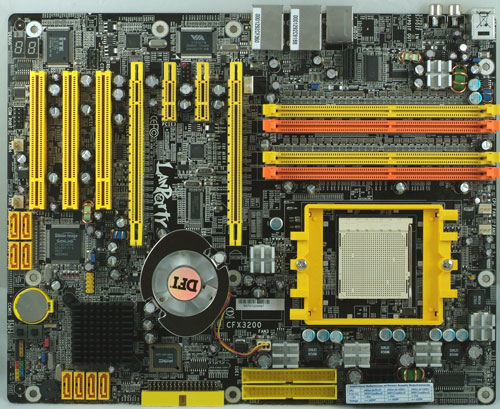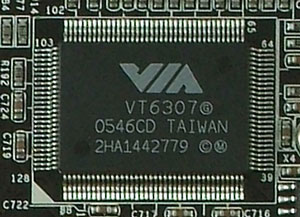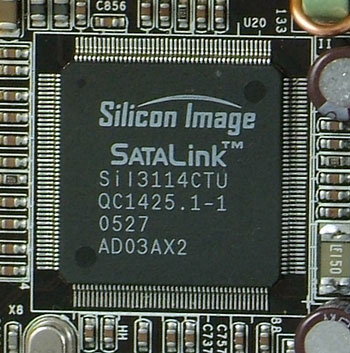DFI CFX3200-DR: ATI RD580 Tweak Attack
by Wesley Fink on May 8, 2006 12:05 AM EST- Posted in
- Motherboards
Board Layout

It has been quite a while since DFI released a new LANParty board with all the bells and whistles. Lately the new DFI boards seem to be LANParty UT - basically a LANParty board without the FrontX unit and Carrying harness. Since there are no full-blown LANParty versions of any of these recent boards, DFI should probably just drop the LANParty name since it no longer has any real meaning in their product line. The DFI CFX3200-DR is selling for over $200, however, which is still a LANParty price tag.

The DFI CFX3200-DR uses the ULi M1575 south bridge instead of the SB450 that was used on the RDX200. That means full support for 4 SATA2 devices, and fully competitive USB performance with 8 USB 2.0 ports. Of the current choices available to ATI chipset builders the ULi looks like the best choice. There are concerns about continued availability since NVIDIA bought ULi. Manufacturers fear that NVIDIA will limit or stop distribution of the M1575 Southbridge. Despite NVIDIA and ULi assurances it certainly appears that the M1575 is getting harder and harder to find these days. The good news is that the updated ATI SB600 with a much updated feature set is now sampling. With the SB600 expected at AM2 launch in a few weeks manufacturers will finally have a competitive ATI SB option for use with the RD580 Northbridge.
DFI decided to pass on the 2-chip NVIDIA dual X16 solution, so this CFX3200-DR is their first and only dual X16 board. Careful thought went into the X16 slot spacing, as DFI chose the 2-slot spacing to allow plenty of room for GPU cooling options.
 |
| Click to enlarge |
Appearance of the board is typical LANParty, with Day-Glo slots and matching neon cables. This is a love/hate kind of thing - some love the LANParty look while others prefer a more sedate appearance. The functional layout, on the other hand, is one that should work well for any system builder.

IDE/Floppy connectors are on the preferred right edge of the board, but it will be easiest to connect the floppy edge connector before screwing down the board.

Both the 24-pin ATX and the robust 8-pin 12v connectors are at the right board edge, out of the way of CPU and memory cooling.

Memory is in an unusual location, between the back IO ports and the CPU. This is not a common location but it works just as well as the more common location to the right of the CPU. Since the AM2 version will be the same except for DDR2 slots it will be interesting to see if DDR2 memory trace design may have influenced this new location. With many systems now using rear case fans, the RAM location may also provide for better cooling of the DIMMs, so while different the change certainly isn't bad.

Firewire has been ignored by DFI on many recent boards, but that is not the case on the CFX3200. A rear firewire port is included as well as a header for an additional IEEE1394 port. Firewire is driven by the VIA VT6307 chip. Some Firewire users would probably still like to see 1394B support, but 1394A is better than nothing.

As in previous LANParty motherboards, DFI has isolated HD audio on their ATI chipset designs to improve performance and signal-to-noise ratio. The Karajan module provides 8-channel High Definition Azalia audio using the Realtek ALC882. The Realtek is a well-regarded High Definition codec that has performed well in recent tests. Realtek has been upgrading their HD drivers frequently, and each new version seems to improve the performance a bit more. You can find more information on ALC882 HD at Realtek's site.
The ALC882 has superb specifications, providing five 24-bit stereo DACs and three 20-bit stereo DACs driving the multimedia features. All DACs provide sample rates to 192kHz and up to 4 channels of microphone input are supported. Signal-to Noise ratio is specified to be greater than 103dB. Realtek features the ALC882 as a premium HD part.

It is a real puzzle that DFI continues to use the Silicon Image 3114 SATA controller on their motherboards. This chip only supports the older SATA spec of 1.5Gb/s, and it has not been a stellar performer in our earlier reviews. With so many excellent and more recent choices available from Silicon Image, it appears DFI must have a warehouse full of these chips to get rid of. Better choices would have been the 3132 or the 4-channel version of that chip. The use of the SIL3114 is not a critical problem on the CFX3200 because the ULi M1575 does provide 4 SATA2 3Gb/s channels for SATA drives. It is just odd the SATA add-on chosen would be the older, less featured 3114.

The DFI CFX3200-DR provides a large compliment of rear IO connectors, including both in/out coaxial S/PDIF; however, there are no connections for Optical S/PDIF. 6 USB ports and 6 programmable audio mini jacks are accessible on the rear panel. There are also two Gigabit PCIe connections, Firewire, and the typical PS2 mouse and keyboard ports. If a parallel port is still important to you for printer connections you won't find one on this board. Serial port connectors are also absent from the real panel, but you will find a COM header on the motherboard in case you need a serial port.

A standard and welcomed feature on top DFI boards is the diagnostic display and the power on and reset momentary switches. These are both very useful for a diagnostic testing when errors occur and for testing the board outside a case. DFI is very serious about the enthusiast target market for their motherboards. This shows in features like the diagnostic display and on-board switches. It is also reflected from the design of the board to the use of the best components rationally available for capacitors and other components.










25 Comments
View All Comments
Stele - Wednesday, May 10, 2006 - link
IMHO the main disadvantage of using the Sil3114 instead of a newer SATA controller like the 3132 is not so much the 1.5Gbps transfer rate, but the fact that it's PCI-based and hence badly bottlenecked once you fill all four channels. 1.5Gbps is a theoretical maximum and HDDs today are nowhere near that limit - in fact we left ATA-133 without even breaking the ATA-100 limit. Since each SATA HDD gets a dedicated 1.5Gbps channel, arrays won't saturate the SATA interface either - rather, they would saturate the slow PCI interface as previously mentioned. Furthermore, the other significant feature of SATA II - NCQ - is of virtually zero relevance to most users, unless one is using the board in a corporate server; not impossible, but not likely either. Therefore, to harp on a figure that has generally been more a marketing tool (as was ATA-133) than a real necessity says little of the real issues at hand.In return, using the Sil3114 means using a tried and tested product whose characteristics are very well known by now. Board engineers would know how best to design around it - what special requirements (signal integrity, trace lengths, coupling etc), if any, need to be factored in, how the controller performs and behaves and so on. Furthermore, the 3114 provides 4 SATA ports for maximum expansion capability - there is no 4-port version of the 3132 as you alluded to in the review - not yet anyway. You may well be right about having a truckload of 3114s to get rid off, so that's likely a factor too. Perhaps when the 3132 gains a 4-port counterpart (and DFI finishes off 3114 inventory) then we may see newer stuff to come. :)
On another side note, yes there would probably be many people who would appreciate the insane options in BIOS, but I do agree that they should make the UI more user-friendly, e.g. by having Automatic as a choice and/or by placing advanced options in sub-menus to distinguish them from the main options. That would satisfy enthusiasts of all levels, from the mad hatters down to the ones who are just starting out. :)
Generally a review well done! :)
Stele - Wednesday, May 10, 2006 - link
Perhaps that statement should be clarified/qualified a little - there is no 4-port version of the 3132 (i.e. PCIe + SATA II + 3.0Gbps) in a single controller IC. The 3132 supports, and hence is expected to be used with, SATA port multipliers - primarily the SII 3726, which can support up to 5 drives. In future, DFI could use a 3132 with one SATA channel routed to an external connector (as in the Asus A8N32-SLI) while the other channel could be connected to a 3726 to provide an additional 4 or even 5 internal HDD channels.
However, this would create two problems - the need for another IC (the board is already very cramped as it is!) and, as already discussed, the need to gain sufficient experience with the new ICs in the lab before they can be confidently implemented and designed around. Cost and time-to-market factors may also have played a role in DFI's choice.
proamerica - Monday, May 8, 2006 - link
This is a poor quality review. The reviewer complains too much about variables that actually improve performance when handled by the right person. The overclocking potential of this board is beyond all other 939 boards I have owned, including the A8R32-MVP... People all over the place are reporting the highest overclocks ever achieved for memory and CPUs. You have to know what you are doing I'm afraid, and yes it requires using all the settings in the BIOS. That is the caveat of buying this board, its hard to use, and it takes time to figure it out, but once you do its worth it. I stably OC'ed my X2 3800 to 2940Mhz, and I currently run it 24/7 at 2700Mhz. Is 2940Mhz the highest OC I have ever gotten with this processor? Yes, stably, by far the highest. One of the greatest aspects of this board is that it will overclock really high but it doesn't take a lot of voltage to get things stable.Why does the review say: "but this DFI does make us wonder how many end users will actually devote the time to master 32 levels of drive strength, and DQS skew levels of +/- 0 to 255 in 511 levels." Lets see, an extremely expensive motherboard from a company known for making the most tweakable boards around... And you wonder if end-users are going to bother? Yeah they're going to bother. If they don't, they should have purchased something else.
Bottom line, this board beats the A8R32-MVP hands down, its just harder to use than the Asus.
Wesley Fink - Tuesday, May 9, 2006 - link
The review pointed out what you clearly found. It's a difficult board to master, but the options and performance can be outstanding. Some want to take the time to master it, others would prefer a board that is easier to overclock. The real poiunt is the DFI CFX3200 still needs work. The BIOS does NOT need to be so difficult to master, and it wouldn't be if more intelligent choices were made for auto settings.The CFX3200 is not a bad board, it is just a very difficult board to use and master - even for an experienced enthusiast.
Zoomer - Wednesday, May 10, 2006 - link
As mentioned by someone else, the auto (default) settings are nicely choosen - for BH5 memory.Perhaps it would be wise to point that out somewhere, or provide an option of memory: BH5/Normal/Valueram/Manual
ozzimark - Monday, May 8, 2006 - link
"Running four double-sided 512MB or 1GB DIMMs is much more demanding than running two DS DIMMs, and like almost every board we have tested the Command Rate needed to drop to 2T with 4 DS DIMMs."using a high dram drive strength should allow for stable opteration at 1T with 4 double rank sticks in.. :)
bigtoe36 - Monday, May 8, 2006 - link
From the Tweak guide on the bleedinedge forum."Max async latency - options 7 thru 10 are all you should need, 7 for agressive tight timings 10 for high fsb overclocks. This option HAS TO BE SET MANUALLY
Read Preamble - 4.5 thru 6 is all you need worry about, 4.5 for BH5 etc and 6 for high fsb overclocks. i usually use 5.5 and 6. Again HAS TO BE SET MANUALLY"
http://www.bleedinedge.com/forum/showthread.php?t=...">http://www.bleedinedge.com/forum/showthread.php?t=... for the full guide.
Wesley you have the options posted on page 4 the wrong way round, its easy to do as I often get them confused.
Tony
ozzimark - Monday, May 8, 2006 - link
with dfi boards, it's long been my experience that manually setting MAL/RP is a VERY BAD thing.bigtoe36 - Monday, May 8, 2006 - link
Normally that would be the case but DFI were setting 4.5 and 5 as hidden defaults. Now if you are running Bh5 you will have no problems, but most everything else would have issues.Thats why i quoted in my guide and on MANY forums you have to set these manually to get the best from the board.
mbhame - Monday, May 8, 2006 - link
Where's the USB/Firewire CPU Utilization and I/O? Where's IDE performance?Throughput is not indicative of real-world performance for any user I know.